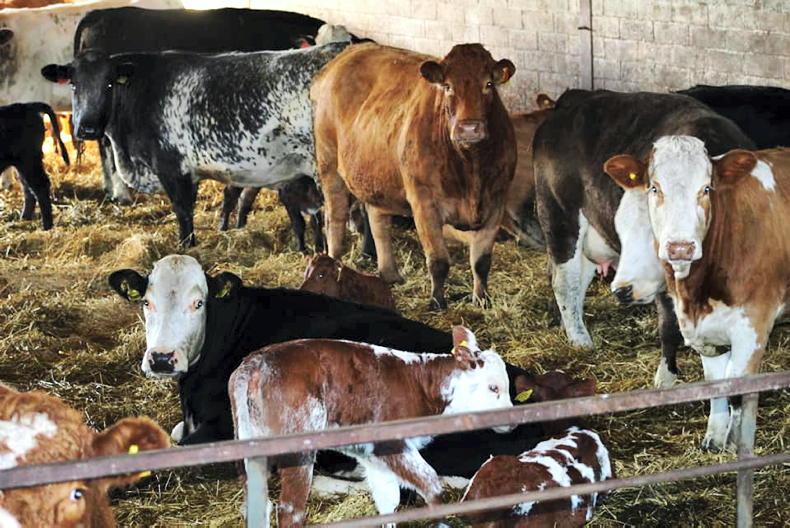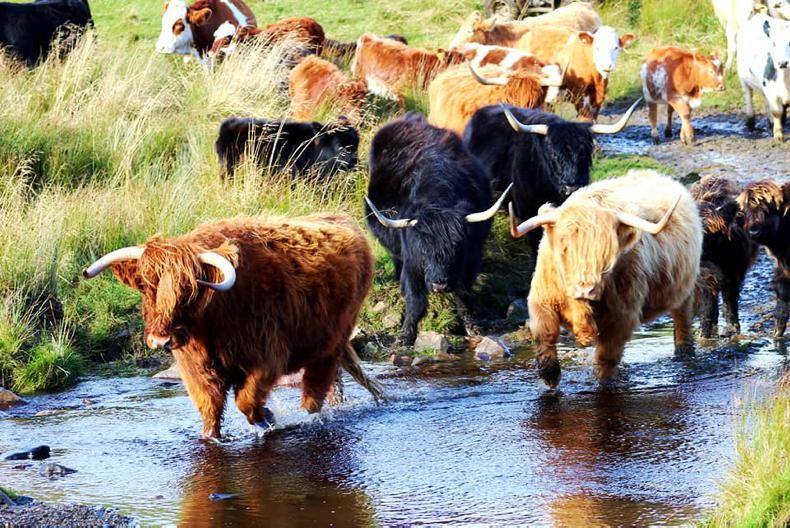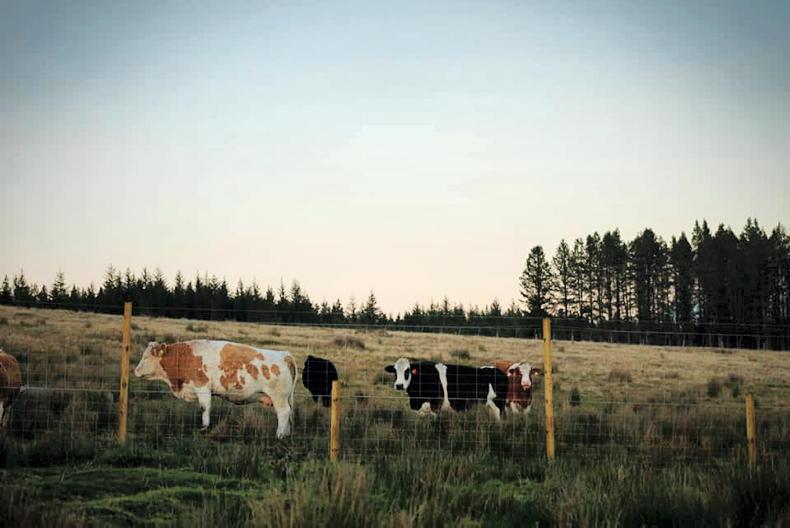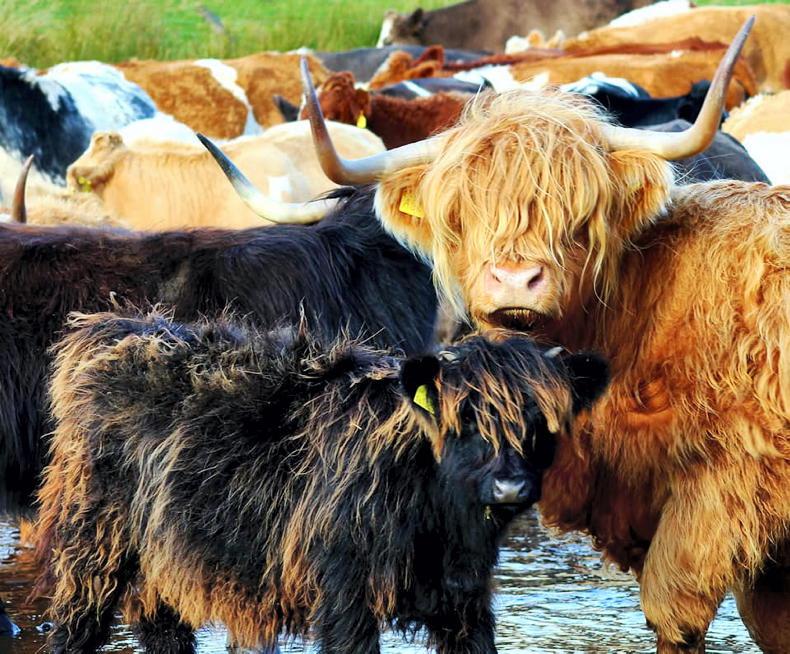“It has been frosty but also very wet so far this month,” Andy Duffus told us this week. “We had some snow but it didn’t last long. The earliest I have seen snow up here is October but it is as per usual so far this year.”
Grass hasn’t been growing on the farm for the last month but there is still a good amount left in the parks that have been reserved for tupping.
Tups in Tomintoul
This year the farm is running four Blueface Leicester, two Suffolk cross, six Texel and for the first time three other Texels have been sold to be replaced by two Hampshire Downs. The 14 tups will be needed for breeding with 498 ewes which started on 20 November. This puts the outdoor lambing starting in the middle of April and as Andy is only giving the tups one month, lambing will be finished by mid-May.
Andy paid an average of £320 for three Blueface Leicesters this year
Tups on the farm typically last a few years, with the current oldest male sheep reading six years while Blueface Leicesters typically last only a couple of years. Andy paid an average of £320 for three Blueface Leicesters this year and £220 each for his two new Hampshire Down tups.
To maximise ram lifespan, Andy buys them in natural condition and avoids anything which looks to have been pushed too hard.
Avoiding big horns at lambing
Out of the nearly 500 ewes, half are Blackface being put to Blackface, Bluefaced Leicester and Texel tups. The Blackface tups will be pulled out two weeks into the month-long breeding to ensure all purebred Blackface lambs are born at the start of lambing and will have less-developed horns in the males. Later-born male Blackface lambs with larger horn development can cause significant problems at delivery so Andy wants to avoid this at all costs.
The later the lamb is born during the season the larger and more developed it is likely to be due to the mother getting improved nutrition from the late spring pasture.

Autumn-calving cows with calves.
The remaining 200 Mules will go to the Hampshire and Texel tups. To top up numbers, Andy bought 22 Cheviot gimmers for £98/head which he plans to put to the Bluefaced Leicester tup to create Cheviot Mules for either breeding or selling.
“North country Cheviots do well on the farm but they are stubborn,” admitted Andy. Historically the farm ran Blackfaced and Cheviots but 10 years ago Andy switched to Mules. Alongside the Cheviots, Andy has also bought 38 Blackfaced gimmers and 40 Mule gimmers all averaging £125/head. “This is the highest I have ever paid for breeding stock,” said Andy. “But then again the finished price has been so good. I hope it stays that way until I get all my lambs away!”
There were also 20 four crop Mule ewes bought and 86 retained gimmers. This made 206 new breeding females for the flock, much higher than the usual turnover. But Andy explained that five years ago he bought 200 gimmers which have now come through the system.
Lambs
So far this year, Andy has sold 170 lambs with prices averaging between £77 to £87/head and has 356 left on the farm. Of the lambs left, 116 ewe lambs will be retained for breeding as gimmers next year. Some 120 lambs are going to be sold store in the coming week as the trade has been strong these last few weeks and the final 120 will be finished off the stubble turnips they are currently grazing.
The stubble turnips have been strip grazed by the lambs for the last six weeks. “They took a bit to get on to them,” said Andy. “But after eating the tops off the lambs moved on to the bulbs. They are really flying now.”
Straw
This year, the farm has 250 round bales and 20 big square bales for winter. From this, 120 have been produced at home but it was a poorer crop than usual. The bought-in bales were £15 per bale off the field for the squares and £6.50 round bale. Andy then hauls them home, making the straw equivalent to around £45/t home.
“I buy the straw from the same farm every year so I know they are baled dry which makes a big difference,” says Andy.
Cattle on the hill
The 90 spring-calvers are all still outside with only the Simmental cross cows planned to come inside in February, six weeks before calving.
Spring cows will be weaned this coming week, with the calves coming inside to a diet of baled silage, draff and bruised barley. Meanwhile, cows will go back outside with some going on to turnips and the remainder on to stubble turnips. While outside, they will also get access to straw or hay and silage. 
Andy sold the offspring from his hill cows at 18 months for £950/head.
Out-wintering his cattle is something which is relatively recent for Andy on the farm. One of the key motivations was straw tripling in price to over £20 a 4ft round bale in 2018. Growing fodder crops has dramatically reduced the cost of wintering and made cattle easier managed. If it is a good spring Andy might put all the cows outside to calve to reduce disease buildup. But typically turnout for farms in the Cairngorms is the middle of May.
To get an early turnout Andy has focused on improving his soil management with significant amounts of lime having been applied. “Getting the soil right means we can get going early,” believes Andy. “The first fertiliser is generally applied at the start of April, once the soil reaches 5°C.”

The 30 autumn-calving cows do need to be housed all winter. They are currently on a diet of silage, draff, straw and barley in a TMR, ahead of the bulls going in next month.
Selling calves
The back end calves from last year are to be sold before Christmas as they approach 450kg each. The spring-born Simmental cross calves from this year will be going away next year in batches once they reach around 450kg/head.
The Highland and Shorthorn calves will be kept and grazed on for the summer next year. This year’s crop were sold for £950 to £980/head at 18 months of age. They were summered on good grass and rotationally grazed.

“I am still building numbers for the hill herd so quite a few of the females are being retained, reducing output,” said Andy. “But once I get up to my number I will look to sell some heifers for breeding since running a hill herd seems to be a success.”
“It has been frosty but also very wet so far this month,” Andy Duffus told us this week. “We had some snow but it didn’t last long. The earliest I have seen snow up here is October but it is as per usual so far this year.”
Grass hasn’t been growing on the farm for the last month but there is still a good amount left in the parks that have been reserved for tupping.
Tups in Tomintoul
This year the farm is running four Blueface Leicester, two Suffolk cross, six Texel and for the first time three other Texels have been sold to be replaced by two Hampshire Downs. The 14 tups will be needed for breeding with 498 ewes which started on 20 November. This puts the outdoor lambing starting in the middle of April and as Andy is only giving the tups one month, lambing will be finished by mid-May.
Andy paid an average of £320 for three Blueface Leicesters this year
Tups on the farm typically last a few years, with the current oldest male sheep reading six years while Blueface Leicesters typically last only a couple of years. Andy paid an average of £320 for three Blueface Leicesters this year and £220 each for his two new Hampshire Down tups.
To maximise ram lifespan, Andy buys them in natural condition and avoids anything which looks to have been pushed too hard.
Avoiding big horns at lambing
Out of the nearly 500 ewes, half are Blackface being put to Blackface, Bluefaced Leicester and Texel tups. The Blackface tups will be pulled out two weeks into the month-long breeding to ensure all purebred Blackface lambs are born at the start of lambing and will have less-developed horns in the males. Later-born male Blackface lambs with larger horn development can cause significant problems at delivery so Andy wants to avoid this at all costs.
The later the lamb is born during the season the larger and more developed it is likely to be due to the mother getting improved nutrition from the late spring pasture.

Autumn-calving cows with calves.
The remaining 200 Mules will go to the Hampshire and Texel tups. To top up numbers, Andy bought 22 Cheviot gimmers for £98/head which he plans to put to the Bluefaced Leicester tup to create Cheviot Mules for either breeding or selling.
“North country Cheviots do well on the farm but they are stubborn,” admitted Andy. Historically the farm ran Blackfaced and Cheviots but 10 years ago Andy switched to Mules. Alongside the Cheviots, Andy has also bought 38 Blackfaced gimmers and 40 Mule gimmers all averaging £125/head. “This is the highest I have ever paid for breeding stock,” said Andy. “But then again the finished price has been so good. I hope it stays that way until I get all my lambs away!”
There were also 20 four crop Mule ewes bought and 86 retained gimmers. This made 206 new breeding females for the flock, much higher than the usual turnover. But Andy explained that five years ago he bought 200 gimmers which have now come through the system.
Lambs
So far this year, Andy has sold 170 lambs with prices averaging between £77 to £87/head and has 356 left on the farm. Of the lambs left, 116 ewe lambs will be retained for breeding as gimmers next year. Some 120 lambs are going to be sold store in the coming week as the trade has been strong these last few weeks and the final 120 will be finished off the stubble turnips they are currently grazing.
The stubble turnips have been strip grazed by the lambs for the last six weeks. “They took a bit to get on to them,” said Andy. “But after eating the tops off the lambs moved on to the bulbs. They are really flying now.”
Straw
This year, the farm has 250 round bales and 20 big square bales for winter. From this, 120 have been produced at home but it was a poorer crop than usual. The bought-in bales were £15 per bale off the field for the squares and £6.50 round bale. Andy then hauls them home, making the straw equivalent to around £45/t home.
“I buy the straw from the same farm every year so I know they are baled dry which makes a big difference,” says Andy.
Cattle on the hill
The 90 spring-calvers are all still outside with only the Simmental cross cows planned to come inside in February, six weeks before calving.
Spring cows will be weaned this coming week, with the calves coming inside to a diet of baled silage, draff and bruised barley. Meanwhile, cows will go back outside with some going on to turnips and the remainder on to stubble turnips. While outside, they will also get access to straw or hay and silage. 
Andy sold the offspring from his hill cows at 18 months for £950/head.
Out-wintering his cattle is something which is relatively recent for Andy on the farm. One of the key motivations was straw tripling in price to over £20 a 4ft round bale in 2018. Growing fodder crops has dramatically reduced the cost of wintering and made cattle easier managed. If it is a good spring Andy might put all the cows outside to calve to reduce disease buildup. But typically turnout for farms in the Cairngorms is the middle of May.
To get an early turnout Andy has focused on improving his soil management with significant amounts of lime having been applied. “Getting the soil right means we can get going early,” believes Andy. “The first fertiliser is generally applied at the start of April, once the soil reaches 5°C.”

The 30 autumn-calving cows do need to be housed all winter. They are currently on a diet of silage, draff, straw and barley in a TMR, ahead of the bulls going in next month.
Selling calves
The back end calves from last year are to be sold before Christmas as they approach 450kg each. The spring-born Simmental cross calves from this year will be going away next year in batches once they reach around 450kg/head.
The Highland and Shorthorn calves will be kept and grazed on for the summer next year. This year’s crop were sold for £950 to £980/head at 18 months of age. They were summered on good grass and rotationally grazed.

“I am still building numbers for the hill herd so quite a few of the females are being retained, reducing output,” said Andy. “But once I get up to my number I will look to sell some heifers for breeding since running a hill herd seems to be a success.”










 This is a subscriber-only article
This is a subscriber-only article











SHARING OPTIONS: